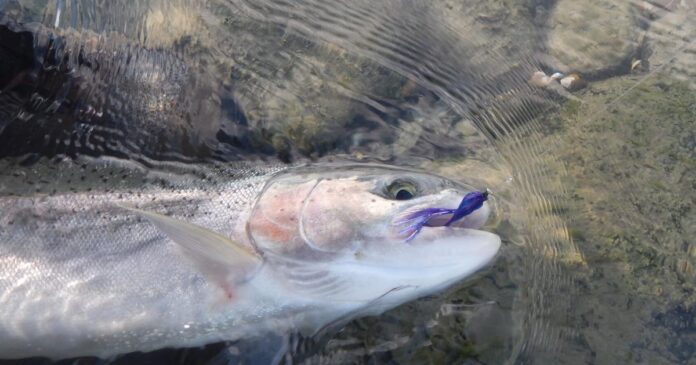Leaden skies promise welcome rain, but nary a breeze stirs the water surface. A small flock of pelicans gives a splash of white to the upstream tip of a gravel bar island. Across the river, the Hanford Nuclear Reservation hides behind tall sand dunes and cottonwood roosts for bald eagles. I weave my truck through a dense grove of Russian olive trees to where a trio of RVs gather around like covered wagons.
A 40-foot-wide band of cobble is exposed between reed canary grass and the Columbia River where water levels dropped overnight. No fly fisher swings a fly for steelhead and no bait caster tosses roe for fall Chinook salmon. A solitary guide boat with three bundled-up clients drifts downstream silently with the current.
The Hanford Reach intimidates. It’s a half-mile wide, has swift, divergent current, and rugged shorelines drop off into a 60-foot-deep holes. The key to success for steelhead anglers is finding accessible shorelines where submerged boulders, rocky points and shallow runs provide cover.
It had been three long years without a season for steelhead on the Hanford Reach, a place where I worked and played for over four decades. Although a longtime fly fisher for trout, casting spinners on the Reach was my forte until Spey casting caught my attention.
The Spey cast is basically a roll cast that involves a change in direction. The style allows for long casts in places where a back cast is compromised. Four basic movements typically come into play: lift and set, anchor, D loop, and forward stroke. Not as complicated as dancing the Macarena, but close. Rods that range from 11 to 15 feet long allow for casts up to 100 feet, depending on casting style, type of line, and wind conditions.
Dick and his buddy Art emerge from their RVs to greet me. “How’s fishing?” I ask.
“Slow,” says Art.
“Have you caught any?”
“Only caught two in 10 days of fishing and both on the other side of the river,” Dick replies.
Dick travels from the Puget Sound to fish the Hanford Reach whenever it opens for steelhead fishing. I call him “the master” because he makes Spey casting look easy. Art, a relative newcomer to the sport, often joins him for a week or two.
A boat gets you to more places to cast from, but Dick begged off me motoring 8 miles upriver from the north Richland launch. “Not sure I could have climbed in your boat with a sprained ankle. How ’bout I give you a refresher lesson instead,” he says, sensing I had not picked up my 11-foot-6-inch “two-hander” Loomis fly rod in over two years.
Following a half-hour of catching up on family matters, I wade ankle-deep into the river and strip line off the reel. Loops in long dormant line straighten as the no. 4 October Bright catches current. “Take six more strips,” Dick says. After watching me flail the water, he offers, “Let me show you the Snap-T.” His demonstration leads to more flailing, after which he remarks, “I’d give you a head slap, but I don’t want to walk that far.”
A feeling of ineptness is barely eased when Art offers, “It took me awhile to get the hang of it.”
They wander back to solve problems of the world while I mutter to myself and work down the shoreline. My technique slowly improves, but line tangles when I imagine them talking about me. Admittedly, my Spey casting style reminds of my downhill skiing. It ain’t a pretty sight to behold. However, with practice comes acquired skill.
One week later I return to the Hanford Reach. This time arriving on my own terms, to a less accessible shoreline where I caught my first steelhead on a fly. I hike across a field of senescent knapweed and star thistle and duck down a worn path crowded with prickly wild rose. The cleats of my wading boots scrape on wet river cobble. A large raft of coots holds position offshore. Upriver gusts of wind send senescent cottonwood leaves fluttering to the ground.
A slow run transitions to a riffle where current breaks over a lineup of washtub-size boulders, ending in an eddy that gathers foam. No better holding spot for over-wintering steelhead, I think. Over the next few hours, I refine my Spey casting technique and get familiar with the river again, thus increasing the odds of catching a steelhead next time out. As I rest my backside on a flat rock crusted with dried algae, cumulus clouds gather and the plaintive honk of incoming Canada geese serenades to remind fishing isn’t always about catching a steelhead.
The Hanford Reach was set to close to steelhead fishing Nov. 15 unless returns to the Ringold Springs hatchery improved. With the John Day River closed, the Deschutes and Grande Ronde Rivers remain as options for area Spey casters to ply their luck. According to the Washington Sport Fishing Rules pamphlet, the lower Walla Walla and Tucannon Rivers are open for steelhead angling. Their tight quarters are suited to drifting a bobber and jig with a one-hand fly rod, in addition to traditional spinning gear. Fish should move into lower sections of both streams following the recent freshet.
My next trip to the Hanford Reach will be on the opposite of the river and require a change in casting style. “Try the Perry Poke,” Dick texted when I asked for advice. An hour of YouTube videos later and I’m ready to focus on having a soft anchor, followed by a correct angle of sweep. Watch out, steelhead! Here I come!
Credit: Source link































